Bugging out requires a bug out backpack first and foremost. After that, you need to decide on gear with space and weight in mind. Why not combine the need for a light with a designated weapon light for bugging out?
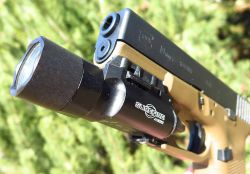
Mounting a light on a weapon, whether long gun or handgun, is a necessary option for every bug in and bug out scenario. The light is not just for discriminating among potential targets, but also to light the escape route, to light the impromptu medical theater, and to signal others as needed. I can easily imagine that more than a few muskets were raised in the presence of nothing more than candle or lamp light.
But gunfighting with a left hand full of lamp oil is like chasing a bad guy with a lit Molotov Cocktail in your fist. Thinking about it further, I imagine the classic off-axis FBI flashlight hold has roots in holding up a candle in the vain attempt to illuminate a bump in the night since a spherical light source like a candle in between good guy and bad blinds both with prejudice towards the closer candle holder.
Once torches moved from flame to battery, it was inevitable that flashlights would be taped, bolted and otherwise affixed to shotgun barrels. Rifles were a pipe dream given that the excruciating low lumen count made targets more than 10 yards away remain forever in the shadows.
Weapon Lights 101
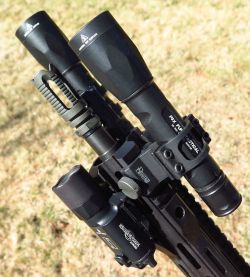
As duct taped flashlights became the glow dejour those in the lighting industry took notice. Even though the number of lumens was somewhere between few and pitiful, the mechanics of mounting and powering weapon mounted lights grew legs and started to walk. But even before LEDs could run, the roots of local lighting while gunfighting were well established and there was no turning back.
In the distant past there was a body-mounted light in the form of a two-D cell 90-degree flashlight affectionately known during WW2 as the TL-122 and later the MX991/U during following conflicts. Ignoring the heavy weight and under-poweredness of the lights, they required not just the head to be on a swivel but the whole body. Only where there is a correlation between gun barrel output and major light axis does the pair become the perfect team to control the dark.
Time Out
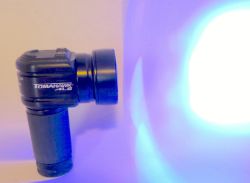
A quick divergence here is that I have an LED light that is somewhat exceptional. It takes its cue from the 90-degree lights of the past but this little beauty not only rises to the top of LED general lighting but also flashes the sharp blue and red colored impulses of the Good Guys. Although my “First Light Tomahawk LE” works well conventionally as a flashlight, I don’t intend to run the light as a light, but instead when needed I plan on making it do the red/blue light strobe dance across the neighborhood walls before engaging the bump in the night. I can use the blinking light to spray strobing red and blue photons throughout the inside of my house, or hit the white side any nearby house, or light up my backyard with enough red and blue light to create an abundance of legal confusion.
New Technologies
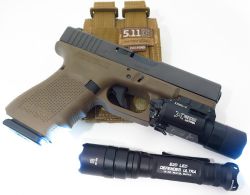
The amazing technological advances in portable lighting and battery power has pushed weapon-mounted lighting into a new world order of lighting. By dumping Thomas Edison’s wiggling filaments, LEDs (Light Emitting Diodes) forever pushed us into the triple and quadruple-digit lumens ultimately gaining my loyalty to the tiny green squares of chemical magic. The massive brightness, hours of runtime, and durability beyond belief has made weapon-mounted lighting an essential component of being prepared even if it’s cost routinely runs north of two bills.
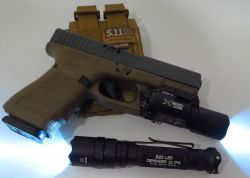
As a reality check, what must be kept in mind is the timestamp on the information you believe. Anything weapon mounted lighting advice that predates LEDs is worthless. Even early generation LED intel is sketchy at best. Way too much of the misinformation about weapons lighting floating around is based on filament-based solutions of the past.
Today, the light spill alone negates any aiming issues, and the massive battery power of the CR123 Lithium cells makes dated knowledge not only useless but dangerous. The old days of pointing your gun in order to point your light are gone. Today’s triple-digit lumen counts compared to the low double-digit lighting numbers of the past make gun lights completely non-specific.
In fact, to further negate the FBI flashlight hold, the über bright WMLs (Weapon Mounted Lights) of today not only blast light across the landscape, but also spill so much excess light in all forward directions that you will be illuminated at best and silhouetted at worst. Therefore the historical concern of your light being a target of the bad guy is a fallacy since aiming a gun at the modern gun light is like staring at the sun. Most likely an offhand shot might be taken at the light, but it similar to keep your hand in a campfire. It’s just too much to tolerate with any accuracy.
DIY your LED
So unless your talents, training and needs lean towards the Spec Ops side, you don’t need much more than a high-end flashlight bolted to your gun. Leave the pressure switches, strobes, and ungodly brightness to the Delta Force boys. For general bug out needs, simple is better and better is effective.
Ten Key Weapon Light Points
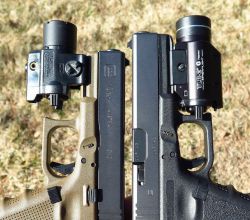
Here are ten observations to help organize weapon-mounted lighting choices since in the entire history of the world there has never been more weapon light options than there are right now. And a little bird told me there would be more tomorrow.
1. Get a weapons mounted light. If it’s not appropriate to use, then don’t use it. But if you need it, there is no substitute for a WLM. None. Period.
2. Three hundred lumens is a nice round minimum give or take 100. The light must be bright enough for target ID at a short distance through spill alone. If you need to read a map, then use something else or cover the light with your fingers. Remember, use the right tool for the job and always err on the side of the primary use. I have weapon lights from 150 to 1000 lumens. Although more is usually better, don’t let lumen levels keep you from preparing now.
3. Having the combination gun and light frees up 50% of your hands for other things. Do not discount that simple fact! If you have to holster your sidearm or sling your rifle in order to enter new territory, then you just made your first mistake. Well, second actually (see point #1).
4. Choose batteries for specific use. If the light will be stored, then use CR123 cells since they have a 10-year shelf life and plenty of immediate power even in sub-zero temperatures. Double-A batteries are great if you want to use the light often, and only use the odd ducks like CR2 batteries if extreme light weight or a tiny size is needed.
5. Avoid using the weapon light for a light. Use the weapons mounted light for a weapons-mounted light. Use a flashlight for flashlight use.
6. Any light mounted behind the muzzle will cause a shadow opposite the barrel with it’s size proportional to the distance back from the muzzle end. On a rifle, consider moving your BUIS back a few inches and mounting the light on the top rail forward of the sight. This will force the shadow under the barrel which will then give you full lighting spill when carrying at low-ready.
7. Strobes can disorient both sides of the muzzle. Avoid them for bug out lighting or use them sparingly. They can also make people sick, induce headaches and even Epileptic seizures, and cause balance issues as well as increase fear for everyone involved. The threat of lead poisoning should be enough.
8. Practice turning the light on and off. You don’t want to struggle in the darkness trying to remember how to turn it on. Some lights allow both a screw-tailcap and a tail pressure switch. Some click. Some twist. Some toggle. Some have complex user interfaces with feature cycling while others change with each button push or with the duration of depression.
9. Many dedicated weapon lights for bugging out have only one gear so off is the only battery-saving option. Runtime might be in minutes to an hour at full blast, but hopefully with diminishing brightness before blackout. To save energy avoid using the mounted light for non-weapon scenarios.
10. Always have a hand flashlight or two (or three) as well. Weapon mounted lights are – obviously- on weapons so the same gun safety rules now apply to the light.
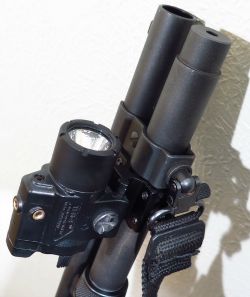
4 Firearm Points
1. Treat every weapon light as if it were a gun that can fire.
2. Never point your light directly toward anything you don’t want to destroy.
3. Remember that what’s beyond your light is not beyond the reach of your bullet.
4. Keep your finger off the trigger until you are ready to fire.
Oh, and one more thing. Do practice with your light especially live fire because the harmonics of your gun may be influenced by a WML. Many of the polymer rails on autopistols could be susceptible to feeding or cycling issues when a WML alters the flex of the frame during recoil. Hopefully it will be a non-issue, but shoot a few hundred just to be sure.
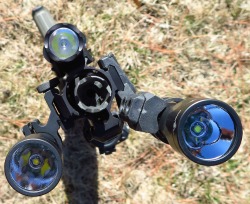
Have vs. Want
The next time I get mugged, it will be in broad daylight, under a noon blue sky, inside the lobby of a police station, during SWAT open house, while POTUS is in attendance, and I just happened to have started my demonstration of how to load an MP5 with live ammo.
Unfortunately statistics are not on my side. Most violent encounters in the US happen after the sun is well on it’s way to China. In other words, it’s dark. So training with a weapon mounted light is an important piece of the survival puzzle.
FBI stats have shown that over 50 percent of LEOs that were killed in the line of duty met their end during the hours between 8pm and 6am. And even worse, 92% of all assaults on LEOs occurred between those same hours. While you might not be a LEO, the risk of assault, robbery, and pretty much everything nasty in between is more likely to happen at night. Thus the need for a WML. But also the responsibility of the gun owner to absolutely know his target. Wandering in the dark is ignoring 80% of the input the brain prefers to use to process a situation. Sight is our dominant sense, and light is essential for sight.
Not all LEOs were giddy about dedicated weapons lights when they arrived. In fact, it was the K9 officers who were first in line to adopt WMLs. With one hand perpetually attached to a dog leash, they had only half the number of available upper torso appendages to begin with. By making gun and light one unit, the K9 cops could move around more like their unleashed brethren.
Where to Mount Your Light
Now that WMLs are powerful enough to be practical on a rifle, it really is only a matter of time before you get one. But where to put it? Many modern ARs have three linear feet of rail or more, but only the final two inches near the muzzle will work for a light. If you have a fixed front sight, you probably don’t want to mount the light on the top rail since the photons will hit the first object they encounter the hardest (the front sight) and under maximum intensity it causes an unacceptable hotspot that will compromise your vision and aiming.
If you are right handed, you might want the light opposite your support hand’s grip (the left side). That leaves the bottom rail and the right side as good choices. A bottom mount behind the muzzle will create a shadow above the gun, while a right mount will create a left-side shadow and can cause issues when rounding corners just as a left-side mount will.
For forest and ranch work, I don’t mind the under barrel mount on my AR. In this case I would rather have a clean view of the ground for safer travel. But a simple twist of the carry position moves the light into the 9 or more likely the 3 o’clock position minimizing any forward shadowing when needed.
Most mounting choices lock-in the light in one of the 90-degree positions: 12 O’clock, 3, 6 and 9 O’clock. The two things to consider are light activation by the support hand, and preferred shadow position opposite the light.
If an intermediate option to the four standard coordinates is desired consider options such as the Daniel Defense light mount or the Magpul offset light mount. A downside to the Magpul mount is that it is screwed onto the rail (two bolts), and the flashlight is attached to the mount (two more bolts), so switching between using the light in-hand and-on gun takes time and tools. The Daniel Defense option is much simpler but three times as expensive. It uses a single large knob to attach the mount to the rail with the light held to the mount like a scope in a ring.
Blowback

Muzzle blast and recoil can damage lights and coat their lenses with light-diminishing debris. Some lights like my now-discontinued Leupold have synthetic sapphire lenses to deal with the harsh life of living next to muzzle blast. Other lights might seem tough at the store, but a few mags later are crying for mommy.
While I thoroughly appreciate the effort Leopold put into their now-defunct MX modular flashlight system, it should have been built for continuity with interchangeable LED modules since the lens, battery barrels, and switches are good for decades but the LEDs are evolving faster than the Avian Flu. So much good tech has gone to pasture due to fixation on the present.
Lights must be strong enough to shake off gun recoil. While LEDs usually ignore impacts, the circuits, switches, battery contacts, and lens components can get their bell rung. Batteries have mass and thus prefer to remain still when the rest of the light is accelerated in a direction opposite of the bullet.
Simple Newtonian mechanics. This can lead to compression of the springs and contacts that normally ensure a complete circuit that keeps the electrons flowing. Darkness falls whenever there is a break in the circuit causing the light to blink or go out all together. And sometimes the electricity never flows again. But this is a double-edged coin to mix my metaphors. Any working light will work until the trigger is pulled. So basically you have at least one shot with any WML. Good lights will keep running. Weak lights…well, you need to move to plan B.
Moving Parts
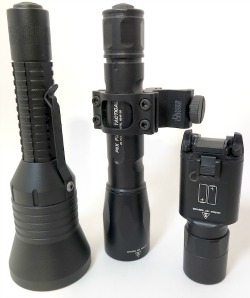
Most good lights have O-ring seals at all material interfaces. But that won’t necessarily keep the light from unscrewing itself over time or during repeated fire. Keep an eye on the connections between components, and give the light a good shake every once in a while to listen for parts rattling around inside the tube.
And speaking of moving parts, the design of the switch on paper is completely different from the operation of the switch in a human hand, especially when contacting that wonderful opposable thumb we’ve been taught separates us from the rest of the animal kingdom.
The thumb switch should have the right amount of resistance and tactile click to talk back during the activation. Of all my lights, there is just something about the Surefire and Fenix lights that have that proper click. Although you might have noticed that Fenix does not make any WMLs. That’s because they do, but they are marketed under different brand names and non-competition clauses will prevent Fenix from selling any for at least a few more years.
Toyota spends millions on the feel of it. And so does Geissele, Magpul and Daniel Defense. You see there are very few places on a weapons light that involve human interaction so those companies that pay special attention to the human-flashlight interface are those that I prefer.
The reason for stressing this particular tangent of weapons mounted lights is that when the S hits the Fan, your pulse spikes, adrenaline is dumped into your bloodstream, and your vision tunnels, the operation of a WML must be like every other human reaction that has evolved over millions of years. Not time for memorized luminosity sequences. No time to wonder, to paraphrase Sigmund Freud, if a click is just a click.
Another area to consider is the composition of the lens. Super-high-end lights use sapphire glass material, the same stuff in your Rolex watch crystal. Moving down in price is impact resistant glass of sufficient thickness, followed by glass. Then polycarbonate plastic. Then plastic of unknown origin. But anything near the business end of a rifle should not be made of a meltable oil-based material like plastic.
Bolt Upright!
Mounting solutions run from simple to complex, and cheap to expensive. If the light has a built-in rail mounting option, then the rail slots must match the light’s size. On full-sized auto-pistols like the Glock 17, small form-factor lights may generate a substantial gap between trigger guard and light. A raw fact to keep in mind is that if a solidly mounted light extends further forward than the pistol’s barrel, it will be possible to jam the gun into the perp without concern of a misfire due to the slide being pushed rearward and out of battery while the business end of the gun squishes into the flesh of the bad guy.
To put a friendly face on this important fact, there are notable events where a LEOs bacon was saved by the perp punching their unlighted muzzle into the cop’s belly or forehead and jerked the trigger but no bang followed. All possible by the lack of a slightly-forward mounting of a WML.
But…

On the other side of the coin, if you have a light such as the Surefire x300 Ultra you can enjoy the ease of switching the light between guns, hands or pockets. Do note, however, that the x300U fires up quite easily in the hand and pocket compared to traditional dialed-in flashlight designs due to its pressure activation in addition to its switch rotation. I’ve also fired up my x300 just by grabbing the gun out of a case. If done in the dark, you just shot your night vision all to hell. Just food for thought.
Inexpensive and versatile mounts include something like the ExtremeBeam Weaver Mount. For about $14 you can mount any one-inch diameter light to almost any gun. The mount can grab standard rails, or use the included rail mount to secure it to a barrel. I have used this mount on a 20 gauge Remington 870 shotgun in addition to ARs.
There are almost no aftermarket tactical accessories for the 20GA 870 platform since it seems the entire rest of the world only cares about the 12 gauge so I was on my own to find a light mount. Lately I’ve settled in on using the rail mount of the ExtremeBeam Weaver to hold a Streamlight TLR-4 light/laser to my house-bound blued pump blunderbuss.
1000 Is The New Black
For a WML, 500 or more lumens is a great number for a pistol these days. But for a rifle that might breathe some fresh outdoor air once in awhile, 1000 lumens is my new best friend. Surefire makes some triple-cell lights under the Fury name. I have both the tactical version and the regular one. The P3X Tactical Fury has a no-click tail cap switch, but instead just a pressure button that fires the light as long as the rubber is held down.
The Tactical only has one setting…full blast, which limits its general usefulness as a flashlight. To keep the light on, the tail cap must be rotated clockwise. I like to mount this light on the nine O’clock position so I can fire the light easily with my support hand thumb while keeping a tight grip on the handguard. If I want the light to stay on, I just grab the tail switch like the cap on a beer bottle and give it a twist.
The regular P3X Fury has a two-stage tailcap click switch that fires first a 15 lumen beam, the a thousand lumen one if clicked again within a second. I prefer to pocket carry this Fury since most of the time I use it in first gear.
The Dust is Settling
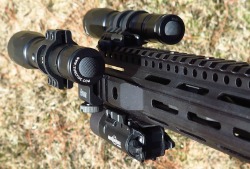
At the moment, we are at an intellectual transition about weapon-mounted lighting. Much of the negative press and skeptical opinions are based upon old knowledge, old designs, old filament lights, and old tactics. Where modern bug out wisdom diverges from conventional law enforcement procedures is with duration of use, location of use, and situational use.
Plus, in a bug out you are hopefully not running towards trouble like the LEOs are paid to do. In a true WROL, I will skew the rules in my favor. As they say, a fair fight is any fight you can lose. I know there are risks to using a weapon-mounted light, but frankly we’ve said the same things about so many other aspects of personal safety until the next generation’s embrace of the technology proved our historical concerns to be no longer founded in 21st century reality. So light it up.
Got a weapon light for bugging out and tell us about it in the comments below.

10 comments
Great article. Getting one of these for my Glock 19 is on the list.
Can I ask if you do more to give away your position than get a good look at what is out there? I would find this useful if I was peering into a spider hole but if defending my home or property, would I be better in the dark and looking for their light?
Got a Streamlight TLR 1S on a handgun. Absolutely no complaints. Not sure the lumens, but if it’s too far away to illuminate with it your not likely to hit it with a pistol. Of your looking for a light I can attest to these working very well on your intended application. Think I got it for around $100
Yes, I have “gun lights”, I do NOT use them in anything but around the home situations. “Gun lights” on law enforcement handguns and long guns ARE bullet magnets from the bad guys. We do not need to use our weapons mounted lights in lieu of a handheld flash to search an area. Do they have their place? Absolutely they do. Using the one on your handgun to “search” an area of your primary residence, may or may not be the smartest thing to do. It ALL depends upon the immediate threat, level of the threat.
Personally, having searched a number of buildings as a law enforcement officer, weapons lights are almost always NOT used, as negligent discharges can and do happen, even to well-trained officers and military service members.
In and around our property and buildings, we have are pre-designated ‘ambush” points where we can safely identify and neutralize threats from any intruders without having ton needlessly expose ourselves and our positions and capabilities to intruders of ANY KIND. Most folks don’t use weapons mounted lights well enough as it is anyway, but they are an excellent tool in the tool box to have.
Thanks for the feedback TPS. I agree with your assessment with law enforcement use of WMLs and the risks for John Q. running around their house with gun and light.
However, my intent is to address the SHTF bug out aspects where there is a very real possibility that the situation will be defensive rather than offensive as well as in an uncertain landscape.
The statistics might not support the casual gun user when it comes to home defense, with fear and weapon mounted lighting just making it worse. But in my case, and I imagine the case of most other readers, a WML is a necessary addition to any and every bug out gun.
In rural areas, the WML is a critical component. Of course we won’t be cranking up the lumens unless necessary, but the open spaces are filled with many threats. And many of those threats, both two and four legged, have great night vision whether organic or generation 1 and better. A blinding light allows one to run through the forest. It might give away your position, but compared to wandering or sitting in the dark hoping to go unnoticed or to get the drop on the bad guy as he stumbles by is not my plan.
I sincerely doubt that when the SHTF and someone enters my space during the night has some level of tactical awareness. Especially when the bar around here is pretty high for gun prowess.
Thanks, Doc, I completely agree. Wasn’t trying to “cast” aspersions on the article at all. Hope my comments did NOT come across as such. I do firmly believe in a “SHTF scenario” whether temporary(civil unrest, etc) or long-term, WML capability is necessary, and ESPECIALLY in rural areas, or other locales where WROL is a very real possibility due to exigent circumstances.
The light points both ways, and the thing is that the shooter who keeps (maintains) light discipline is the one most likely to remain alive.
Turning on a light that is mounted to the barrel of your firearm is nothing more than an express ticket to the afterlife.
If you your need is for an AR in a battle proven format, then get yourself an A2, with bayonet lug, and without any provision for mounting an “idiot light”.
The light points both ways, and the thing is that the shooter who keeps (maintains) light discipline is the one most likely to remain alive.
Turning on a light that is mounted to the barrel of your firearm is nothing more than an express ticket to the afterlife.
If you your need is for an AR in a battle proven format, then get yourself an A2, with bayonet lug, and skip the “idiot light”.
I tend to agree. As long as I am at home and know my way around in the dark very well I would prefer to keep it that way and use it to my advantage, unless the intruded has night vision! Plus if you blind a good guy (family, cops, neighbor) that is trying to help you might get some friendly fire.
My understanding is that you turn the light on, see what you need to see, turn the light off, move. and repeat that unless you need to engage something.
If you are at home, you’ve probably told the threat to leave and that the cops are on the way, so the light isn’t really giving away your position any more than you yelling at them will.
Then, if you are shooting at something, the light’s not really going to contribute to you giving away your position.
“tell the threat to leave and cops are on their way”
You mean the gun fire says go and neighbor calls cops?
You just defined, “to be judged by 9 than carried by 6”